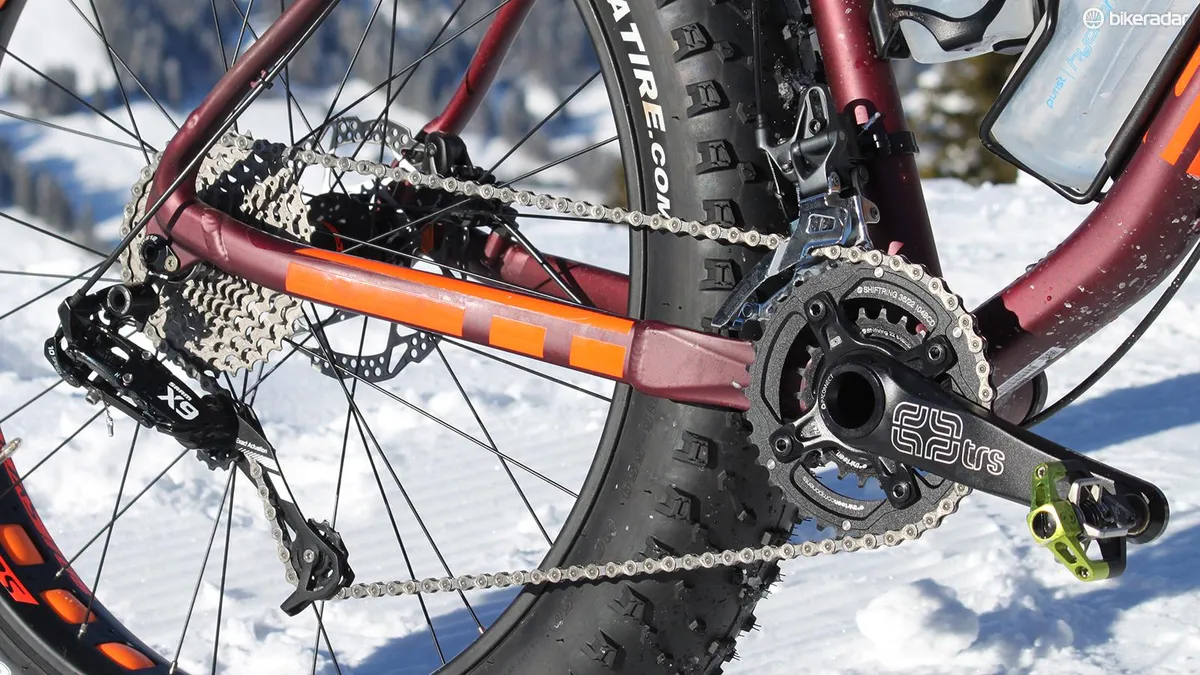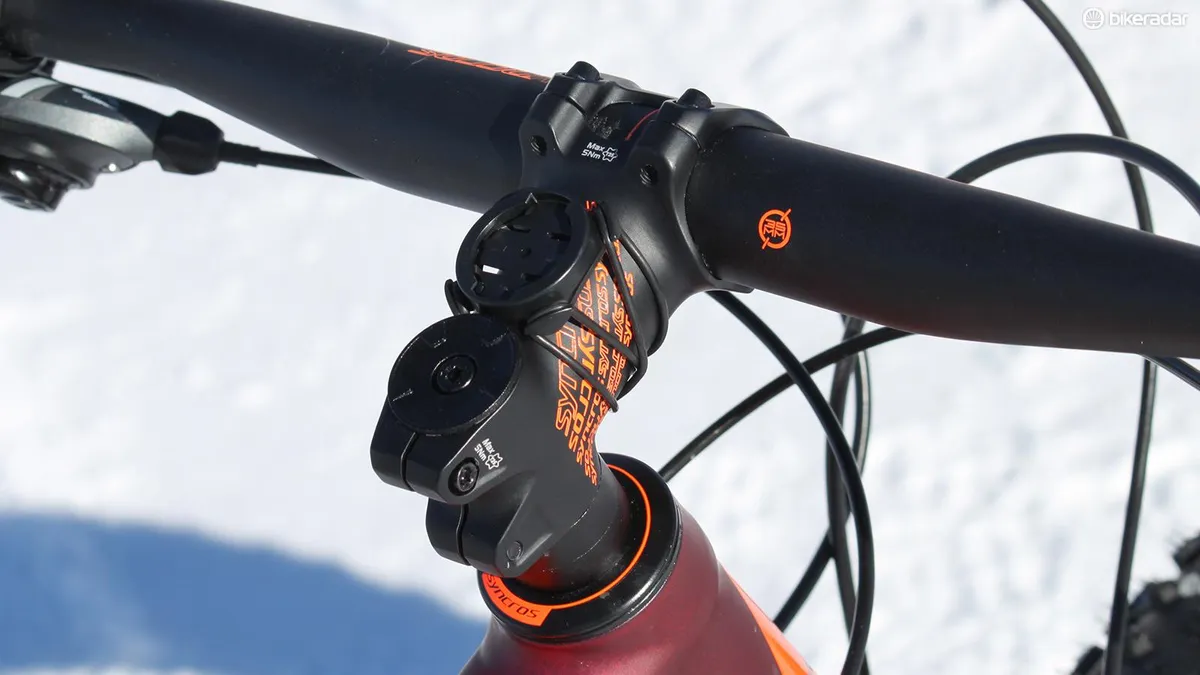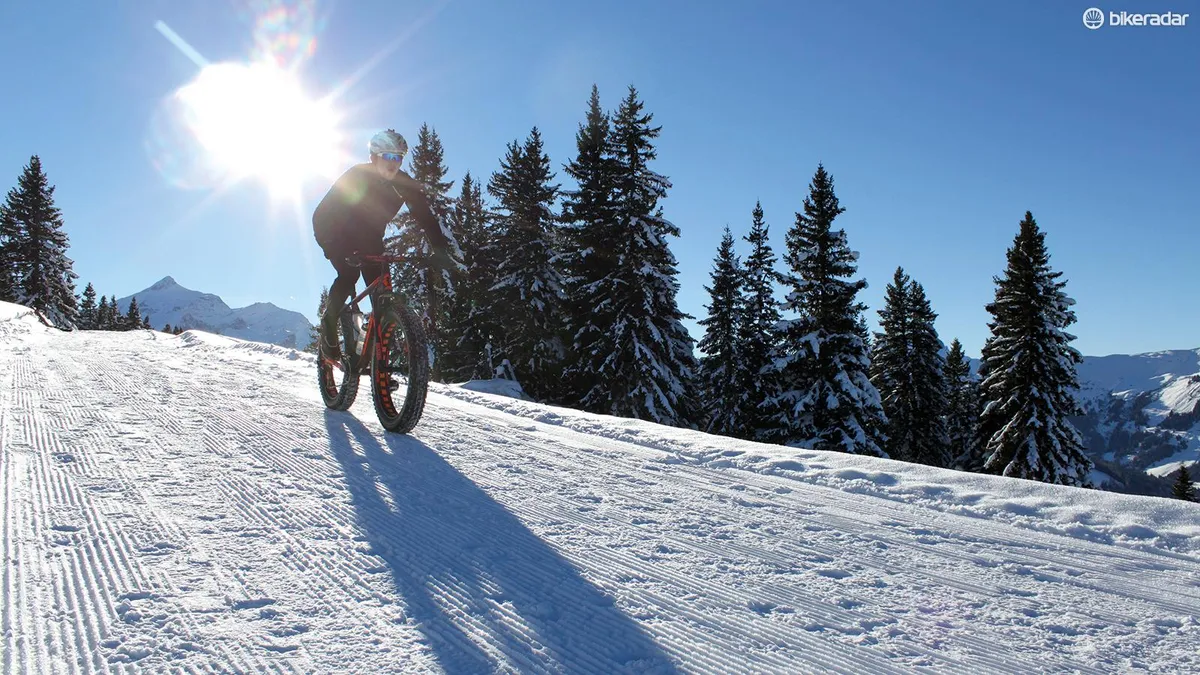Scott’s head office is in Switzerland, so it seemed appropriate that we tested the Big Ed fat bike at the Snow Bike Festival in Gstaad.
For the Big Ed, Scott uses an alloy frame and a double crankset, keeping cost down despite the Bluto suspension fork up front. The downside of this is that it’s a hefty beast, tipping the scales at 15.5kg in size XL.

For our snow racing test, we'd have preferred to swap out the Bluto suspension fork
That fork is very linear and unsupportive compared with most (non-fat) trail forks. This means the remote lockout supplied with the Big Ed was a useful tool for racing and riding, as it otherwise bobs wildly when pedalling out of the saddle.
Left open with the rebound a touch slower than normal, it does a good job of damping the bounce that can otherwise plague fat bike tyres. But suspension isn’t really necessary for racing on snow, and so for our test environment we'd have preferred to save a kilo or so with a rigid fork.
Roomy ride
Swing a leg over the Ed and its roomy and relaxed riding position is immediately noticeable, thanks to a longish 70mm stem and high bar height. At 73 degrees, the seat angle is pretty average for a hardtail but with the fairly long 450mm chainstays, a more rearward saddle position was needed to improve rear-wheel traction when climbing on slippery ground.

Climbing on treacherous ground, it was necessary to knock the saddle back to improve rear-wheel traction
E-thirteen’s TRS double crankset shifted lazily rather than crisply with the SRAM X7 front derailleur, and the large gap between the 22t granny gear and the 36t ring meant front shifts were a real effort – we visibly lost ground to fellow competitors when shifting between them. On the other hand, the wide gearing range was ample for both the steep slogs and fast spins.
Shimano’s Deore brakes have in our experience proved to be the Japanese firm’s most reliable stoppers and this trend continued in Gstaad. They performed faultlessly, even in temperatures as low as -11ºC. With 180mm/160mm rotors they provided way more power than you're ever likely to need on snow, and they were often a little tricky to feather effectively as a result, but this power would be welcome in more ‘normal’ riding conditions.

The Shimano Deore stoppers were the business, as usual, but require very careful feathering on snow
The finishing kit is supplied by Scott’s in-house brand, Syncros. As mentioned, the bar and stem keep things reasonably roomy, but high-speed descents would’ve been a more confident affair with a slightly shorter stem and wider bar. Unfortunately, neither of our testers got on with the Syncros saddle.
An unwelcome tyre change
Syncros provides the wheels too, which aren’t the lightest, but performed without issue. They use a standard (for a fat bike) 80m rim width, producing a fairly rounded tyre profile with our Kenda tyres (the Big Ed comes stock with Schwalbe Jumbo Jims, but our test sample was fitted with Kenda Juggernauts).

The Syncros rims produced a rounded profile with the non-stock Kenda rubber
The large gaps between the central tread blocks meant huge drag in a straight line on hardpack, and the rounded profile dug into snow rather than floating on top. In the corners, the tread was comparatively minimal, resulting in a vaguer feeling in the bends.
At 69 degrees, the head angle is mid-pack for a fat bike, but the steep, slippery, high speed descents would’ve been much more manageable with more stable geometry. The Scott’s suspension fork steepens it when riding, especially on downhills.

Being able to pop out a leg at a second's notice is essential on slippery terrain
When compared with the racy Specialized Fatboy Comp Carbon we also took to Gstaad, the Big Ed simply felt slow. The extra weight was clearly part of this, but those draggy Kenda tyres were the main issue. However, as, we say, the Big Ed should be stocked with Schwalbe tyres, so we won’t mark the Scott down for this.





